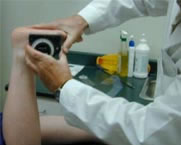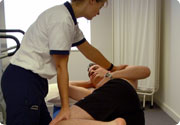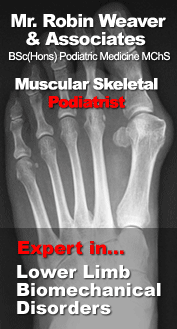 Biomechanical Assessment
Biomechanical Assessment
A Biomechanical Assessment involves a
complex evaluation of the feet, legs and body position whilst
weight-bearing and non weight-bearing.

The average person's feet when walking will only spent six
tenths of a second in contact with the ground. Weight-bearing movement
is usually assessed using hi-tech video treadmill gait
analysis. Alternatively it can be assessed using the Orthomed
scanner which provides a 3D dynamic view of the foot ankle knee
and hip motion. This unique new digital system has
revolutionised the detection and treatment of lower and
associated musculo-skeletal conditions The Orthomed Scanner is a
£30.000 piece of equipment based in Sheffield at the Barn
clinic. It represents the ultimate hi-tech assessment tool which
can capture the complex movements involved in gait. The
Orthomed scanner is one of only five in the UK.
The biomechanical examination is a critical
part of the evaluation for functional foot orthotics. Assessment
includes evaluation of:
Muscle strength, range-of-motion at important joints,
and the angular relationships of the segments of the foot and
leg.
The information gained from a biomechanical assessment
forms the basis for a rehabilitation programme, or if the
problem is mechanical -an orthotic
prescription.
|  The PODIATRIST's evaluation will
mainly concentrate on the assessment of the hip, knee and
ankle joints.
The PODIATRIST's evaluation will
mainly concentrate on the assessment of the hip, knee and
ankle joints.



|

 Hip evaluation involves testing the range of motion
with the knee flexed. Hip evaluation involves testing the range of motion
with the knee flexed.
Range of hip flexion with the knee extended is evaluated.
(Tight hamstring muscles will result in diminished motion.)
 Evaluation of the rear-foot, includes motion at the
sub-talar joint, and its angular relationship to the
lower leg.
Evaluation of the rear-foot, includes motion at the
sub-talar joint, and its angular relationship to the
lower leg.
 Motion at the big-toe joint (first
metatarsal-phalangeal joint) is critical for the forward
progression of the body during gait. A lack of motion
here can cause an early arthritis in the joint, and even
lower back pain.
Motion at the big-toe joint (first
metatarsal-phalangeal joint) is critical for the forward
progression of the body during gait. A lack of motion
here can cause an early arthritis in the joint, and even
lower back pain.
 Limitation on ankle extension may result from tight
calf muscles (Gastrocnemius and Soleus)
Limitation on ankle extension may result from tight
calf muscles (Gastrocnemius and Soleus)
If your condition is caused by a mechanical imbalance
of a joint
the Podiatrist may prescribe
orthotics
Orthotics are devices designed to improve the way in which
joints are aligned.
Before orthotics can be fabricated by the technician,
three dimensional models of your feet or 'casts' must be
constructed. The process of 'Casting' is an extremely
skilled process requiring years of experience and
expertise. Casting involves the
Podiatrist
holding the foot in a specific ‘neutral position’
relative to the lower-limb whist taking the impressions or
'negatives' of the feet. The negatives or models of your
feet are then adapted as prescribed by the Podiatrist. The orthotics are then formed over the
models of your feet.
|
|
...............................
 top
of page
top
of page
 ............................
............................ |

